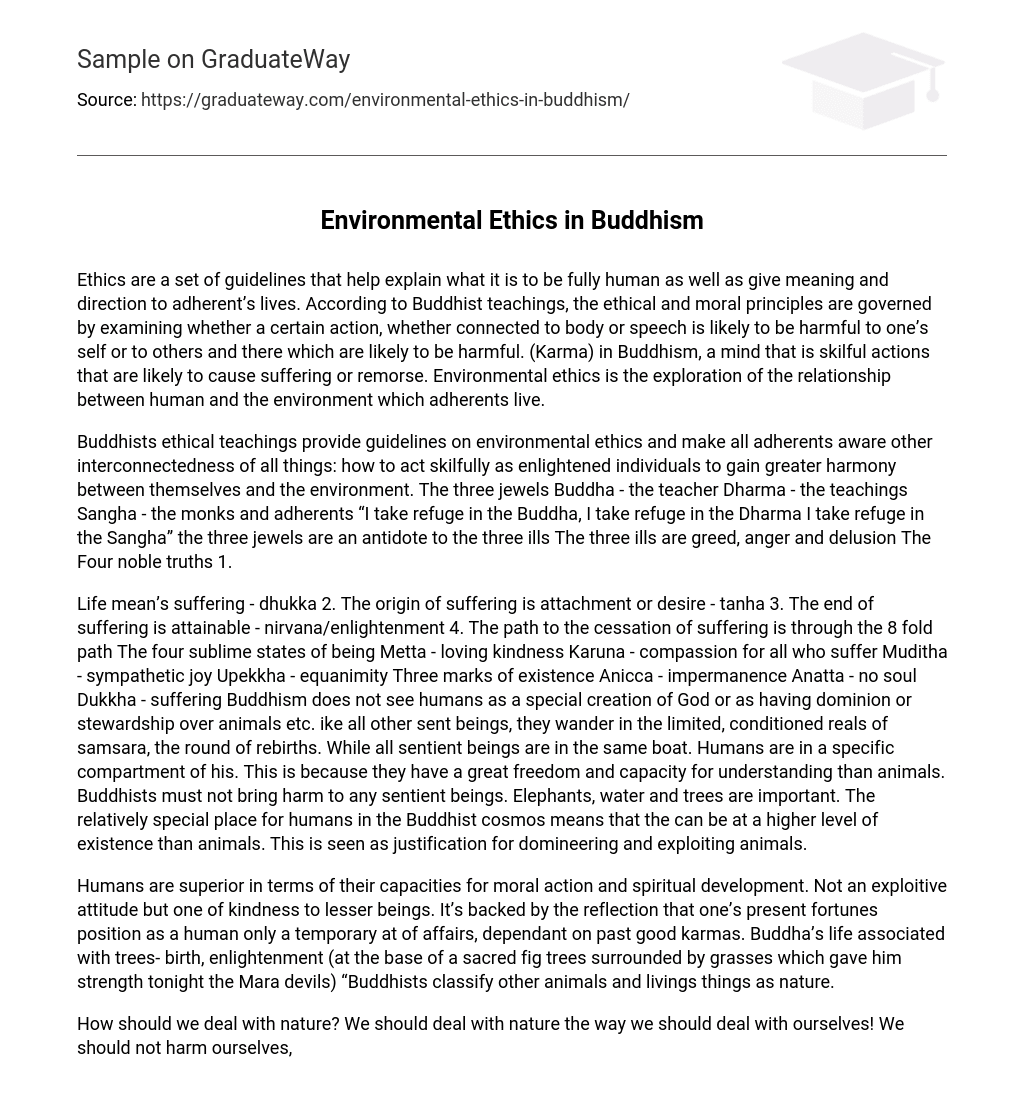Ethics are a set of guidelines that help explain what it is to be fully human as well as give meaning and direction to adherent’s lives. According to Buddhist teachings, the ethical and moral principles are governed by examining whether a certain action, whether connected to body or speech is likely to be harmful to one’s self or to others and there which are likely to be harmful. (Karma) in Buddhism, a mind that is skilful actions that are likely to cause suffering or remorse. Environmental ethics is the exploration of the relationship between human and the environment which adherents live.
Buddhists ethical teachings provide guidelines on environmental ethics and make all adherents aware other interconnectedness of all things: how to act skilfully as enlightened individuals to gain greater harmony between themselves and the environment. The three jewels Buddha – the teacher Dharma – the teachings Sangha – the monks and adherents “I take refuge in the Buddha, I take refuge in the Dharma I take refuge in the Sangha” the three jewels are an antidote to the three ills The three ills are greed, anger and delusion The Four noble truths 1.
Life mean’s suffering – dhukka 2. The origin of suffering is attachment or desire – tanha 3. The end of suffering is attainable – nirvana/enlightenment 4. The path to the cessation of suffering is through the 8 fold path The four sublime states of being Metta – loving kindness Karuna – compassion for all who suffer Muditha – sympathetic joy Upekkha – equanimity Three marks of existence Anicca – impermanence Anatta – no soul Dukkha – suffering Buddhism does not see humans as a special creation of God or as having dominion or stewardship over animals etc. ike all other sent beings, they wander in the limited, conditioned reals of samsara, the round of rebirths. While all sentient beings are in the same boat. Humans are in a specific compartment of his. This is because they have a great freedom and capacity for understanding than animals. Buddhists must not bring harm to any sentient beings. Elephants, water and trees are important. The relatively special place for humans in the Buddhist cosmos means that the can be at a higher level of existence than animals. This is seen as justification for domineering and exploiting animals.
Humans are superior in terms of their capacities for moral action and spiritual development. Not an exploitive attitude but one of kindness to lesser beings. It’s backed by the reflection that one’s present fortunes position as a human only a temporary at of affairs, dependant on past good karmas. Buddha’s life associated with trees- birth, enlightenment (at the base of a sacred fig trees surrounded by grasses which gave him strength tonight the Mara devils) “Buddhists classify other animals and livings things as nature.
How should we deal with nature? We should deal with nature the way we should deal with ourselves! We should not harm ourselves, we should not harm nature… human beings and nature are inseparable. ” thich nhat hanh In the wilderness Buddha developed his spirituality and – made him complete – an essential element in his life – his teachings are found in the wilderness, not in the towns. “In order to protect the environment we must protect ourselves.
We protect ourselves by opposing selfishness we jealousy; ignorance with wisdom, and hatred with loving kindness, selflessness, mindfulness, compassion and wisdom are the essence of Buddhism. We train in meditation which enables us to be aware of e effects of our actions, including use destructive to our environment mindless and clear comprehension are at the heart of Buddhist meditation. Peace with nature is realised when we are mindful of each and every step. ” Abstain from harm – first precept – eating lower down on food chain (vegetarians) – leads to transformational effects.
Need to cut down on water usage, chemical fertilisers and insecticides – is will lead to non-harming. Abstain from drink of drugs – fifth precept -must not affect concentration on meditation – meditation leads loving kindness, compassion for the environment: lead to transaction from greed, hatred and delusion. Green Buddhism is not new. It is simply Buddhist values added to the most urgent suffering (in this case ecological and environmental) at hand – need to focus on self-transformation – greater sensibility needed.
Green Buddhist needs to ground their practices within traditional approaches from Buddha’s dharma. Buddha’s importance through his teachings resides in his symbolic power as reconciler of civilization and nature. Examples The Association of Buddhist for the Environment – tree ordination ceremony in bokor national park working to provide environmental conservation m kampong chnang EE project – to increase the awareness and capacity of monks and villagers to understand connection between Buddhist teachings and the environment.
Ngo partnerships community forestry international – to stabilise and regenerate forests asoke community – against consumerism, simple live and community involvement Tree ordination is one out of the twelve core activities of the ABE. Because trees are recurring theme I stories about the life of Buddha was born in a forest, reached enlightenment in the forest and budda passed away in the forest.





